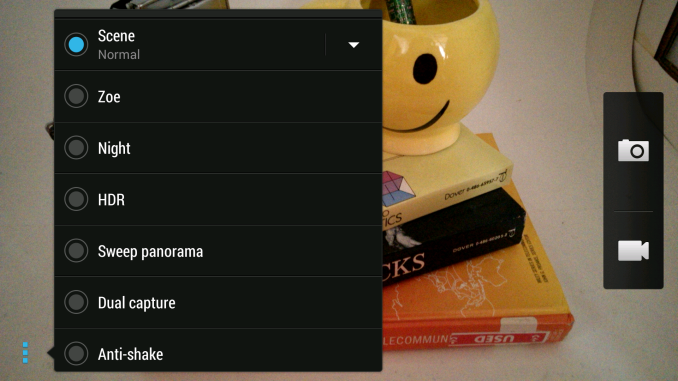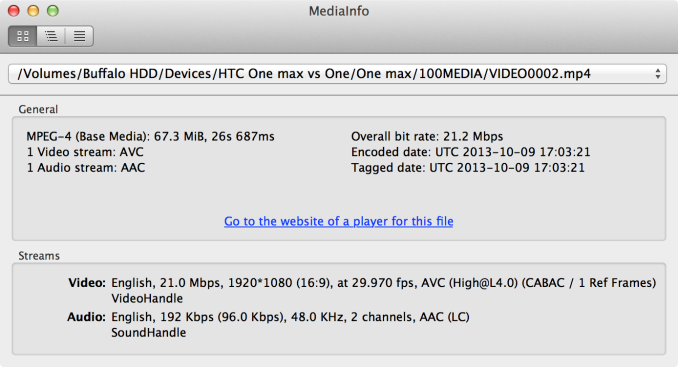HTC One max Review - It's Huge
by Brian Klug on October 28, 2013 10:00 AM EST- Posted in
- Smartphones
- HTC
- Mobile
- One
- Snapdragon 600
- Android 4.3
- One max
On the camera side we see HTC’s continued use of the 4 MP UltraPixel camera sensor on the back, with 2.0 micron pixels and 1/3" size. It’s the same CMOS sensor from ST (VD6869), and the same optics on top, with 3.8mm focal length and F/2.0 aperture. What’s different is that the One max doesn’t have OIS (Optical Image Stabilization), just like the One mini. That’s a bit unfortunate since OIS was one of the real highlights of the One, and we’ve seen another OEM follow suit with the inclusion of OIS to good success (LG’s G2) and will likely see Samsung do the same. On the front facing camera we have an Aptina AS0260 CMOS sensor with 2.1 MP resolution and 1.4µm pixels.
| HTC One Camera Specifications | |||||
| Device | HTC One | HTC One max/mini | |||
| Sensor Size and Type | 1/3" BSI CMOS | 1/3" BSI CMOS | |||
| Resolution | 4.0 MP 16:9 Aspect Ratio (2688 x 1520) | 4.0 MP 16:9 Aspect Ratio (2688 x 1520) | |||
| Focal Length | 3.82mm | 3.82 mm | |||
| F/# | F/2.0 | F/2.0 | |||
| Optical System | 5P | 5P | |||
| OIS | 2-axis +/- 1 degree, 2 kHz sampling | No OIS | |||
My thoughts about the HTC One camera system have definitely evolved over time, though I’m still glad HTC took a big risk and went this way, I’d like to see resolution traded off a bit less in the next generation. Good imaging often takes a balanced approach, I’d love to see larger pixels somewhere around 1.65 µm and as many as possible while still being pragmatic about sensor size. I hate to bring up the iPhone 5s as a comparison point, but something without as far of a tradeoff would be great. I’m still a fan of the HTC One camera indoors where other cameras struggle, but outdoors the resolution tradeoff is definitely there. Losing OIS means losing one of the things about the One system that made it special and standout in my mind. I could understand it being gone in the One mini for cost reasons, but the One max really should’ve had it considering its mission – everything about the One, taken to the max.
There’s a couple new features in the camera as a part of Sense 5.5 as well. Dual capture has been added to the camera as a shooting mode. We’ve seen this from other OEMs – it allows the front facing camera to be superimposed on the rear facing camera, or vice versus.
It’s a great feature for taking a selfie in front of something while traveling, which is ultimately its primary use case, I guess. There’s also an ‘anti shake’ mode which seems to be an EIS enhanced mode, but again this doesn’t preclude getting blurry pictures when the One max takes longer exposures, from what I’ve found.
Gallery: Smartphone Camera Bench
With the exception the performance tradeoff that comes from lacking OIS (higher chance of getting blurry photos from hand shake), imaging performance on the One max is really unchanged versus the One or One mini. I’m not going to go into super great detail here, but again I’d love to see the future One series a bit more resolution without trading off too much sensitivity.
Video
The One max has the same set of video modes as the other One, normal 1080p30, slow motion video, fast HD (720p60) and Video HDR (1080p30). In addition the shot in shot mode also works in video, so you can have yourself superimposed over video of whatever you’re shooting as well.
Video is recorded at a maximum of 1080p30 H.264 high profile with a 21 Mbps bitrate, and stereo audio. 1080p30 is great, but it’d be awesome to see 4K UHD video record which I was spoiled by on the Note 3, that’s another thing that’s a matter of SoC and CMOS needing a bit more.
I took videos on the One max at the standard bench location (MP4) and also compared to the One with OIS to illustrate the tradeoff in stabilized video that comes with its removal. I think it’s fairly easy to make the case that it should’ve been there. I also swear I wiped down the One max front facing glass to prevent glare, but the One max video shows some haze from light leakage. I’d love to see more OEMs move to coated sapphire cover glass on the camera, something I don’t believe HTC has.























































197 Comments
View All Comments
Braumin - Monday, October 28, 2013 - link
The SD cards I agree with, but removable batteries not so much. Manufacturers can include much larger custom batteries into a phone if it doesn't need to be a square battery that pops out the back. Plus, you can easily find microUSB battery extenders, which are FAR more convenient than swapping a battery because you don't need to reboot to do it.SD cards though - I don't think they need to go away until manufacturers (cough APPLE cough) stop gouging customers on increased storage.
Brian Klug - Monday, October 28, 2013 - link
SD cards, far and away, are going the way of the dodo. They're effectively already deprecated by the base Android platform (requiring OEMs to manually backport the ability to move APKs and OBB files over), and 3rd party SD support is pretty much in decline. The handful of applications that I'd expect to natively use the SD card either have it as a hidden feature, or have removed it entirely (I'm looking at you, Spotify).That pretty much leaves them only for use as dumb, manually managed storage. Like it or not, that's the reality.
The context (that you left out) is that I wouldn't trade build quality for an SD card, it makes almost no sense to have a huge removable door on the One max just for the sake of an SD card. The tradeoff is huge here.
Also the other reality regarding removable batteries is you do lose volume that way that could've been dedicated to more battery had it been sealed internally. That's fact.
The data I've seen from OEMs and operators shows that microSD cards get changed by a tiny demographic of users, or even used, if not installed - yes, OEMs had to start manually installing SD cards since users can't be bothered to install them. Continue to cling to 'em, but normal consumers don't care, and the rest of the world has pretty much moved on.
-Brian
apertotes - Monday, October 28, 2013 - link
heck yeah, I like to dumb manually manage my movies and music files without cluttering my apps space. Why is that so retarded? I have 80 gb in my S3, and I only have 10 free. Am I stupid for using a flagship device as a poweruser would? Should I pay $400 for a phone and use it only as an internet connected device? I think that reporters have way to much easy access to new devices and internet everywhere. Why would I stream movies or music if I can have them on my phone, and play them even on the subway or during a weekend on the mountain?There is zero reason not to want expandable space on a phone, other than being able to say "Yes, but this is unibody aluminium". And most reporters are doing half of Apple's job in convincing people that they really do not need a micro-sd card. "Why do you need it, when you can simply pay $10/month for Spotify, and then $40/month for an unlimited data contract to use Spotify?" Well, of course, you are swimming in money, you do not need a micro-sd card. But that is like convincing everybody to ditch their cars and simply call a cab whenever they need it.
Steven JW FCK - Monday, October 28, 2013 - link
Damn straight! You tell em! I mean how much money and infinite 4G signal has this guy got to try and rubbish the Micro SD card.Dentons - Monday, October 28, 2013 - link
It isn't difficult to see why reviewers awash in a torrent of new, free, phones aren't particularly enamored in these features.Reviewers don't use phones for 2+ years.
Reviewers don't have to pay for the larger memory models.
Reviewers don't keep any phone nearly long enough to wear out the built-in batteries.
On the whole, most phone reviewers interests aren't very well aligned with those of a cost-conscious consumer.
kiwidude - Monday, October 28, 2013 - link
Agreed, I'm still using my Galaxy S 8GB + 32GB, on my third battery and would have been forced into a new phone I have no need for if it wasn't for these features. Data here is very expensive so any cloud/streaming solution is impractical. I agree though in a world were the cost of the phone is not important, you update your phone faster than it takes for a battery to die and where you have unlimited data great.rabidkevin - Tuesday, October 29, 2013 - link
Couldn't agree more.. I just finally paid off my galaxy s2 after 2 years. The comments this reviewer makes are insane! He has no idea what he is talking about.superflex - Tuesday, October 29, 2013 - link
Finance a $100,000 house for 30 years. ReasonableFinance a $25,000 vehicle for 4 years. Reasonable
Finance a $600 phone for 2 years. Retarded.
Johnmcl7 - Monday, October 28, 2013 - link
Thankfully you're almost completely wrong on all counts there but it's a surprisingly ignorant post coming from someone who is generally knowledgeable when it comes to technology.Firstly, micro SD cards are not going the way of the dodo - they were in decline but there's been a noticeable turn around in devices supporting the technology. The microSD support in the HTC phone in this review is a turnaround from HTC's previous position and Nokia have brought microSD expansion to their 1520 which is also a change as previously their top end phones (1020, 925, 920 etc.) did not have sd expansion.
As for support in Android, the fact that it's not used in Nexus devices or part of the base system is completely irrelevant as Android builds are usually heavily customised in many areas. Samsung are one of the main Android handset manufacturers and they support microSD across their range, quite seemlessly as well plus Sony although not nearly as big are also sticking with micro SD support. The fact that the micro SD can only be used as 'dumb' data doesn't matter as that's what it is great for, many people criticise SD storage when it was incorrectly used in place of onboard storage (when it was a stupidly small amount). Micro SD expansion is ideal for larger amounts of video such as HD films and music, leaving the onboard memory for applications.
As for a supposed tradeoff, that's a completely nonsense excuse and a really poor one at that - it's easily possible to produce micro SD slots without compromising the build quality, Sony are currently able to produce weather sealed phones with micro SD slots.
And if nothing else, you should at the very least appreciate what SD expansion offers cost wise - the amount of money charged for onboard memory is completely ridiculous, it's far, far more than high speed micro SD cards cost.
I don't believe the data you've seen from OEM's as it doesn't make any sense at all - if such a small amount of people are using them, why do companies keep on putting them there? Why are companies adding micro SD slots to phones? I can't claim my experience to be in any way representative but looking at large deal sites when someone posts a good deal on a micro SD card, the deal usually gets very popular and most people are buying the cards for their mobile phones.
As for batteries being bigger if they're sealed in, that is absolutely not 'fact' and it certainly doesn't always apply in practice. The HTC One is a similar physical size to the Samsung Galaxy S4 (despite the larger difference the screen sizes suggest) yet the removable battery in the S4 is larger than that in the One. Either way, the differences are very small particularly compared with the full capacity of a battery which can be immediately achieved when swapping it out but not on a device with a sealed battery. Given current smartphones can quickly burn through batteries, it make a lot of sense to be able to switch over the battery and be back up to full almost immediately yet frustratingly few companies are now offering user accessible batteries as standard.
Furthermore, the battery is unlikely to last the full two years a phone should and certainly won't while keeping performance. On a device with a removable battery that's not an issue as it's a matter of seconds to swap over but for devices with a sealed in battery it's a much more time consuming and expensive repair.
John
Brian Klug - Monday, October 28, 2013 - link
I don't know how you can be objectively "wrong" about whether or not you think the tradeoffs are worth it, but whatever. I'll address the rest of your points:>As for support in Android, the fact that it's not used in Nexus devices or part of the base system is completely irrelevant as Android builds are usually heavily customised in many areas.
The base platform has deprecated SD card support, plain and simple. You saw the SGS4 launch initially with SD card support that essentially only worked for music and as a storage intent for the camera. Later they added the ability to move application data over by backporting it. Ironically enough today you see NVIDIA doing the same thing with Shield and their own BSP.
>it's easily possible to produce micro SD slots without compromising the build quality,
The context here is the One max, it isn't worth the tradeoff in build quality.
>I don't believe the data you've seen from OEM's as it doesn't make any sense at all - if such a small amount of people are using them, why do companies keep on putting them there? Why are companies adding micro SD slots to phones? I can't claim my experience to be in any way representative but looking at large deal sites when someone posts a good deal on a micro SD card, the deal usually gets very popular and most people are buying the cards for their mobile phones.
Take it or leave it I suppose, but that's the reality. Samsung continues to do it as a differentiation point, as do a few others. I would say however the trend against microSD by OEMs like Google and obviously HTC backs up this claim, rather than your other one.
The anecdote I heard that really made me think about this was that one of the major operators in the USA added a requirement that OEMs preinstall SD cards since users weren't even doing so with the pack-ins. Says something interesting about what demographic even knows about removable storage.
>As for batteries being bigger if they're sealed in, that is absolutely not 'fact' and it certainly doesn't always apply in practice.
Sorry, you are completely wrong here.
Removable batteries need to have a dedicated protection circuit for CE compliance and this adds to volume. In addition they need to be structurally sound, this translates to a plastic frame around the battery itself, and around the volume the battery occupies in the phone. That's the point almost everyone always misses when they start arguing about removable battery volumes versus internal battery volumes, and you can ask any OEM about it, its 100% fact that internally sealed affords bigger volumes in addition to geometries that wouldn't work with a removable battery. Also every OEM shoots for at least a two year longevity. Both LG (and Motorola) have talked a lot about how long they tested their 3.8V chemistry before accepting it.
-Brian